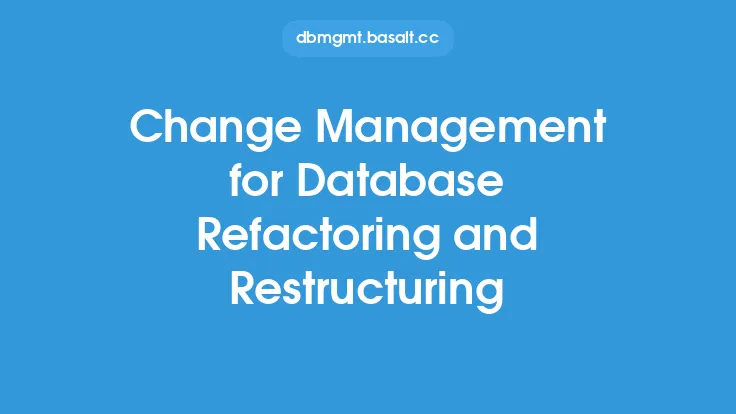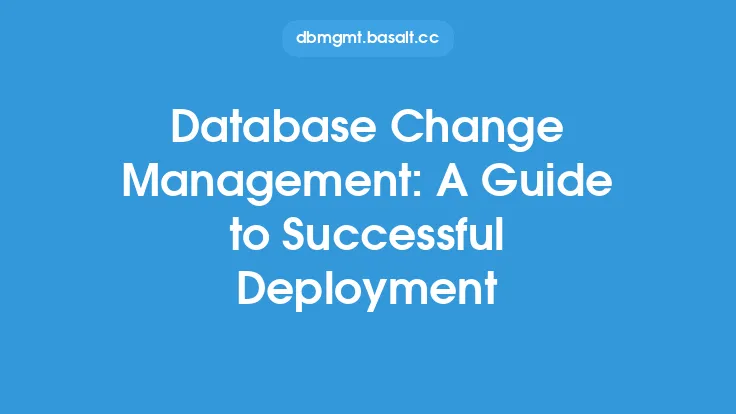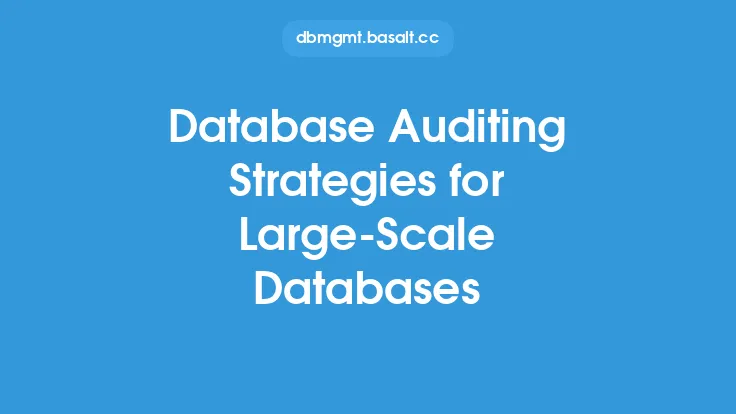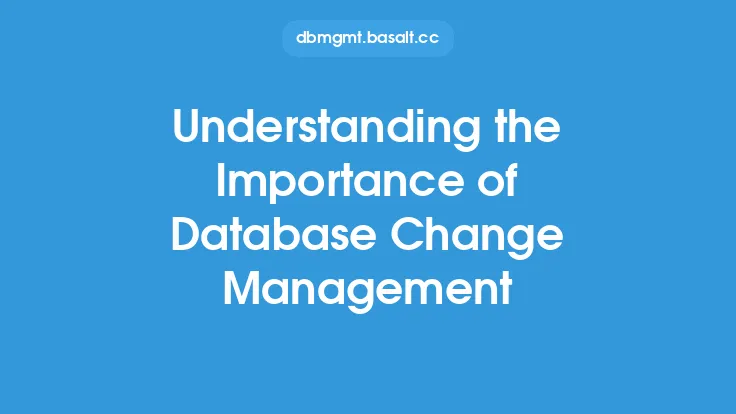Effective communication is a crucial aspect of database change management, as it ensures that all stakeholders are informed and aligned with the changes being made to the database. This involves not only communicating the changes themselves, but also the reasons behind them, the potential impact on the organization, and the steps being taken to mitigate any risks. In this article, we will explore the importance of effective communication in database change management and provide strategies for implementing it.
Introduction to Communication in Database Change Management
Database change management involves a range of activities, from planning and designing changes to implementing and testing them. Throughout this process, effective communication is essential for ensuring that all stakeholders are aware of the changes and their potential impact. This includes not only the database administrators and developers who are making the changes, but also the end-users who will be affected by them. Effective communication helps to build trust and credibility, and ensures that everyone is working towards the same goals.
Identifying Stakeholders in Database Change Management
The first step in effective communication is to identify the stakeholders who will be affected by the changes. This includes not only the technical teams, but also the business stakeholders who will be impacted by the changes. Stakeholders may include database administrators, developers, quality assurance teams, project managers, and end-users. Each of these stakeholders has different needs and concerns, and effective communication must take these into account. For example, technical teams may need detailed information about the changes, while business stakeholders may need to know about the potential impact on the organization.
Developing a Communication Plan for Database Change Management
A communication plan is essential for ensuring that all stakeholders are informed and aligned with the changes. This plan should include the following elements:
- A clear description of the changes being made
- The reasons behind the changes
- The potential impact on the organization
- The steps being taken to mitigate any risks
- A timeline for the changes
- A list of stakeholders who will be affected by the changes
- A plan for communicating with each stakeholder group
The communication plan should be tailored to the specific needs of each stakeholder group, and should take into account their level of technical expertise and their concerns.
Communication Channels for Database Change Management
There are a range of communication channels that can be used to communicate with stakeholders, including:
- Email: This is a good way to send detailed information to stakeholders, and to keep a record of communications.
- Meetings: Face-to-face meetings are useful for discussing complex issues and for building trust and credibility.
- Collaboration tools: Tools such as Slack or Microsoft Teams can be used to facilitate communication and collaboration between teams.
- Documentation: Documentation is essential for providing detailed information about the changes, and for keeping a record of the changes that have been made.
The choice of communication channel will depend on the specific needs of each stakeholder group, and on the culture of the organization.
Communicating Technical Information in Database Change Management
Communicating technical information is a critical aspect of database change management. This involves not only explaining the changes themselves, but also the technical details of how they will be implemented. Technical information may include details of database schema changes, changes to stored procedures or functions, and changes to database security settings. When communicating technical information, it is essential to use clear and concise language, and to avoid using technical jargon or acronyms that may be unfamiliar to non-technical stakeholders.
Change Management Process and Communication
The change management process is a critical aspect of database change management, and involves a range of activities from planning and designing changes to implementing and testing them. Effective communication is essential throughout this process, and involves keeping stakeholders informed of the progress of the changes and any issues that arise. The change management process typically includes the following stages:
- Request: A request for a change is submitted, and the change is reviewed and approved.
- Planning: The change is planned and designed, and a detailed plan is developed.
- Implementation: The change is implemented, and the database is updated.
- Testing: The change is tested to ensure that it has been implemented correctly and that it does not introduce any errors.
- Deployment: The change is deployed to production, and the database is updated.
Throughout this process, effective communication is essential for ensuring that all stakeholders are informed and aligned with the changes.
Metrics for Measuring Communication Effectiveness in Database Change Management
Metrics are essential for measuring the effectiveness of communication in database change management. These metrics may include:
- Stakeholder satisfaction: This can be measured through surveys or feedback forms.
- Issue resolution: This can be measured by tracking the number of issues that arise during the change management process, and the time it takes to resolve them.
- Change success rate: This can be measured by tracking the number of changes that are successfully implemented, and the number of changes that are rejected or rolled back.
- Communication channel effectiveness: This can be measured by tracking the effectiveness of different communication channels, such as email or meetings.
By tracking these metrics, organizations can identify areas for improvement and develop strategies for improving communication effectiveness.
Best Practices for Effective Communication in Database Change Management
There are a range of best practices that can be used to improve communication effectiveness in database change management. These include:
- Develop a clear and concise communication plan
- Identify and engage with all stakeholders
- Use clear and concise language
- Avoid using technical jargon or acronyms
- Provide regular updates and progress reports
- Use collaboration tools to facilitate communication and collaboration
- Document all changes and communications
By following these best practices, organizations can improve communication effectiveness and ensure that all stakeholders are informed and aligned with the changes.
Conclusion
Effective communication is a critical aspect of database change management, and involves not only communicating the changes themselves, but also the reasons behind them, the potential impact on the organization, and the steps being taken to mitigate any risks. By developing a clear and concise communication plan, identifying and engaging with all stakeholders, and using clear and concise language, organizations can improve communication effectiveness and ensure that all stakeholders are informed and aligned with the changes. By following the strategies and best practices outlined in this article, organizations can improve the effectiveness of their database change management processes and reduce the risk of errors or downtime.





